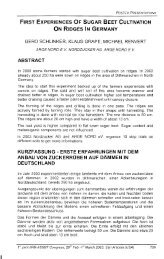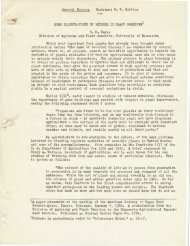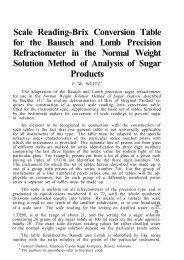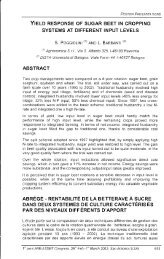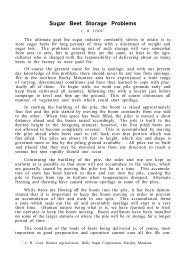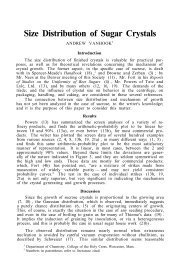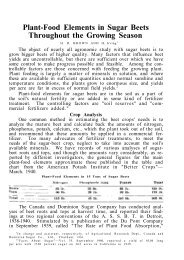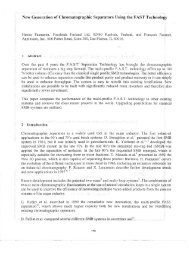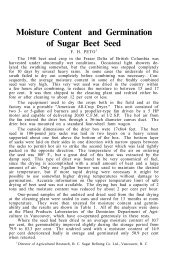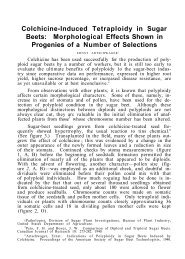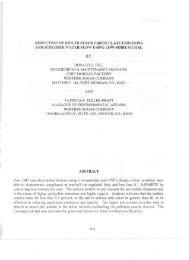Basic Beet Piler Design and its Application to Construction - ASSBT ...
Basic Beet Piler Design and its Application to Construction - ASSBT ...
Basic Beet Piler Design and its Application to Construction - ASSBT ...
Create successful ePaper yourself
Turn your PDF publications into a flip-book with our unique Google optimized e-Paper software.
PROCEEDINGS—EIGHTH GENERAL MEETING 351<br />
The screening of beets was further improved by the use of the reverse<br />
screen rolls strategically located in the screen unit. By the use of reverse<br />
rolls at the proper points in the screen <strong>and</strong> by providing screens of ample<br />
width <strong>and</strong> area so that the beets could spread out <strong>and</strong> allow the dirt <strong>and</strong><br />
trash <strong>to</strong> come in contact with the screen rolls, better <strong>and</strong> greater dirt <strong>and</strong><br />
trash separation has been obtained.<br />
While the use of rubber screen elements is very effective in dirt <strong>and</strong><br />
trash removal, in some districts there has been a tendency for the reverse<br />
rolls <strong>to</strong> pull small beets through the screen along with the leaves <strong>and</strong> trash.<br />
This problem seems <strong>to</strong> have been more pronuounced in certain areas where<br />
mechanical thinning <strong>and</strong> closer spacing of beets prevail, consequently, with<br />
the increase of spring mechanization, a problem has developed which must<br />
be solved. To accomplish a reduction of beet loss a proper relationship<br />
in speeds between rolls running in the forward direction <strong>and</strong> the rolls<br />
running in the reverse direction was made. Thick-fingered rubber screen<br />
elements <strong>and</strong> a combination of steel <strong>and</strong> rubber screen kickers were also<br />
used on the reverse rolls. All of these have brought about an improvement<br />
in the beet screen unit <strong>and</strong> tended <strong>to</strong>ward a solution of this particular<br />
problem.<br />
Another desirable change introduced on pilers during the past two<br />
years consists of adding an independent mo<strong>to</strong>r for driving the screen unit.<br />
This enables the screen <strong>to</strong> be driven separately from the incline conveyor,<br />
thus providing a feature which was not. available with the former driving<br />
method. In the single unit pilers of the 1953 model an independent mo<strong>to</strong>r<br />
drive was used for the auxiliary dirt belt, which made possible the au<strong>to</strong>matic<br />
s<strong>to</strong>pping of the auxiliary dirt belt beneath the screen when the main<br />
dirt belt was discharging in<strong>to</strong> the grower's truck. Thus, the dirt from a<br />
following load would not become intermingled in any way with that of a<br />
preceeding load.<br />
Improved Condition of <strong>Beet</strong> Piles<br />
In the design of beet pilers, much thought was given <strong>to</strong> features which<br />
would improve the condition of beet piles, <strong>to</strong> avoid losses occasioned by<br />
beet spoilage while in s<strong>to</strong>rage. In addition <strong>to</strong> providing the best possible<br />
screening <strong>and</strong> trash removal, other fac<strong>to</strong>rs such as the proper length of the<br />
piling boom, depth of beet pile, distribution of beets across the face of<br />
the pile, etc., all have a bearing on how well the beets will keep during<br />
the s<strong>to</strong>rage period.<br />
The piling boom lengths vary from 50 <strong>to</strong> 60 feet according <strong>to</strong> the type<br />
of piler furnished. With the 48-inch double unit, double platform pilers<br />
the boom can be somewhat shorter than that of the single unit-type pilers.<br />
On the 1953 model, single unit machine, with double platforms, a 55-foot<br />
boom length was found <strong>to</strong> be the most desirable. The width of the pile at<br />
the base is approximately 134 feet <strong>to</strong> 140 feet, <strong>and</strong> the depth of the pile<br />
about 22 feet. All piling boom conveyors are mo<strong>to</strong>r driven from the head<br />
shafts, as it has been found that this location of drive gives the best belt<br />
operation.<br />
For many years the piler booms on Ogden Iron Works Company pilers<br />
have been mo<strong>to</strong>rized for swing, <strong>and</strong> for the past ten or twelve years, au<strong>to</strong>-



